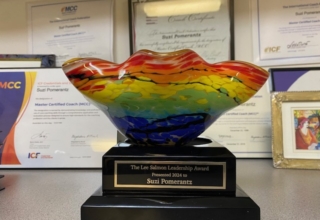
Jake was not satisfied by a general discussion, with coaches in the room saying how they would approach these issues, or with organizational representatives, some from very different industries, sharing their experiences. While this discussion was informative, Jake wanted more. “Aren’t there cutting edge models out there that would put us on the curve? I do telephone debriefs with the partners who have been coached, and I often hear a bit of a choking voice when people talk about the results of their coaching. So we’ve got something that works, but I want to extend it. I want something fresh. I guess I’m starting with a ‘glass half empty’ attitude.”
Co-Coaching plus Empty Chair: The standard format was engaged. The attendees divided in half, a dozen people meeting with Jake to engage in the co-coaching. Jake sat in the client chair. Three coaches agreed to each take a coaching chair and to build on one another’s comments as if they were one coach and one chair was left empty for other people to participate. The questions were indeed what might be expected from a single coach, but coordinated input from three ongoing coaches and any of the rest of the participants who took the empty chair made for rich, deep, and rapid exploration of possibilities. Here is a selected sequence of questions:
• What is your vision for what is possible?
• What benefits would you like to see?
• Why now?
• What works well?
• Could we start dreaming?
Impact and Outcomes: Of several “dreams” offered by various participants including Jake, one evolved into a model of leadership training for a group of 10 or so partners around a theme that they chose, so that they would be engaged in developing their own knowledge and skills. This could have the cost benefit of using in-house staff for facilitation, as confidentiality requirements would change. This would also have the advantage of developing the group’s coaching skills in order to extend a coaching culture throughout the organization. “I promise you that you’ll still get the choking voice,” said one coach.
“That could be put into the category of group coaching,” said Jake, “But it has a lot more meat. That’s what I’ve wanted.” In evaluating the experience, Jake said, “This was just outstanding. I didn’t think I was going to get this much good stuff.” One participant responded, “Sounds like your glass is half full.”
Action Item: Stick with what works—one-on-one coaching—but consider tapping into the need for generativity for coachees. A group model, where they “pay forward” to peers and the organization, may capture their engagement and release their creativity in ways that impact the whole organization.
Download Article 1K Club


















